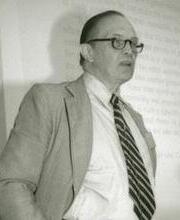George Armitage Miller
Father of the Cognitive Revolution
Cognitive Psychology, Psycholinguistics, and Cognitive Neuroscience

“My problem is that I have been persecuted by an integer.” So began perhaps the most famous paper in the history of experimental psychology. The Harvard psychologist George Miller, inspired by information theory, aimed to measure the “channel capacity” of the mind, and found that three very different tasks pointed to the same answer. People could associate about seven different labels with continuous stimuli (like loudnesses or colors); they could rapidly identify the number dots without counting them up to around seven; and they could hold about seven items in immediate memory. And there was an additional twist. The capacity of immediate memory was the same whether each item was a binary digit (1 bit), a decimal digit (3.3 bits), a letter of the alphabet (4.7 bits), or an English word chosen from a list of a thousand (10 bits). This elasticity suggests that people don’t just passively transmit incoming information but recode it into mind-friendly units, which Miller called “chunks.” Human information processing is thus constricted by a bottleneck of 7 plus or minus 2 chunks. With this remarkable insight, George Miller helped to launch the cognitive revolution (pdf), ushering in a new era of theory and research in American psychology.
At this time Miller was a young professor in Harvard’s Psychology Department. He had received his Ph.D. in Experimental Psychology in 1946, based on his work in S. S. Stevens’ Psychoacoustics Lab in the basement of Memorial Hall during World War II. More than a decade before his most famous publication, Miller had already espoused a view of the human mind that challenged behaviorism by arguing that the mind existed and could be explored scientifically. In his 1960 book Plans and the Structure of Behavior (coauthored with Karl Pribram and Eugene Galanter), Miller proposed that psychologists rethink the basic unit of behavior: not the stimulus-response reflex arc, but the feedback loop. This was a mechanical version of a “plan” or “goal,” but without any mysterious teleology.
Miller’s diverse research interests naturally led him to adopt a more interdisciplinary approach to experimental psychology than behaviorism allowed. To that end, in 1960 he co-founded and co-directed the Center for Cognitive Studies at Harvard with Jerome Bruner of the Department of Social Relations.
“To me, even as late as 1960, using 'cognitive' was an act of defiance," he writes. "It was less outrageous for Jerry, of course; social psychologists were never swept away by behaviorism the way experimental psychologists had been. But for someone raised to respect reductionistic science, 'cognitive psychology' made a definite statement. It meant that I was interested in the mind — I came out of the closet." (quoted in Hébert, 2006)
Miller invited Noam Chomsky to the Center, and the two of them collaborated on an influential series of technical papers on mathematical and computational linguistics. Miller also ran the first experiments testing Chomsky’s theory as a processing model of human language, and the first experiments establishing that syntactic and semantic constraints could guide the perception of speech.
In 1965 Miller was appointed to chair the Psychology Department, a role he filled until he moved to New York City to teach at Rockefeller University in 1969. During his subsequent years at Princeton, Miller helped to found the new field of cognitive neuroscience, and developed Wordnet, a database of words linked by their semantic relations, which has become an important research tool in linguistics.
George Miller’s influence on his colleagues, students, and the field of cognitive psychology is immeasurable. He is listed as number 20 on the American Psychological Association’s list of the 100 most eminent psychologists of the 20th century.
Sources
Hébert, R. (2006). The Miller’s tale: A genealogy of the father of the cognitive revolution. APS Observer 19(6).
Cohen-Cole, J. (2007). Instituting the science of mind: intellectual economies and disciplinary exchange at Harvard’s Center for Cognitive Studies. British Journal of the History of Science 40(4), pp. 567-597.
Eminent psychologists of the 20th century. (July/August, 2002). Monitor on Psychology, 33(7), p.29.